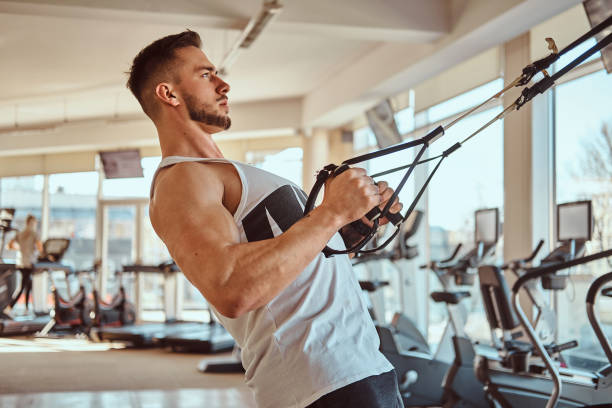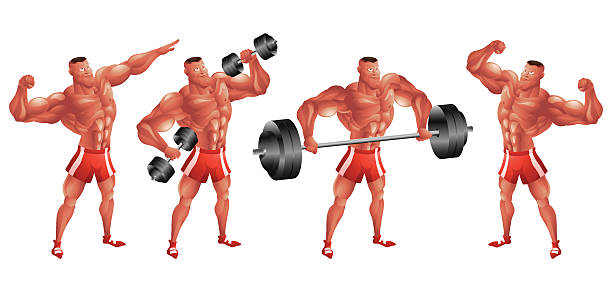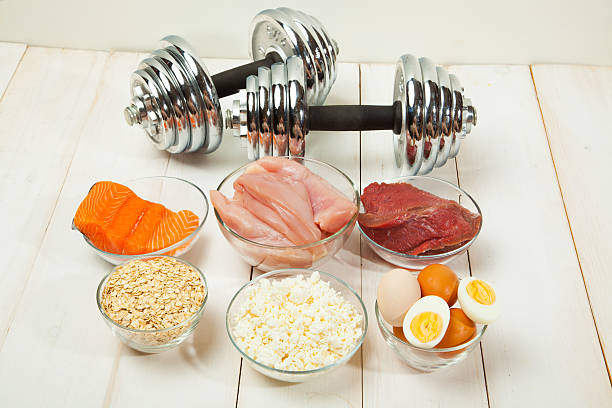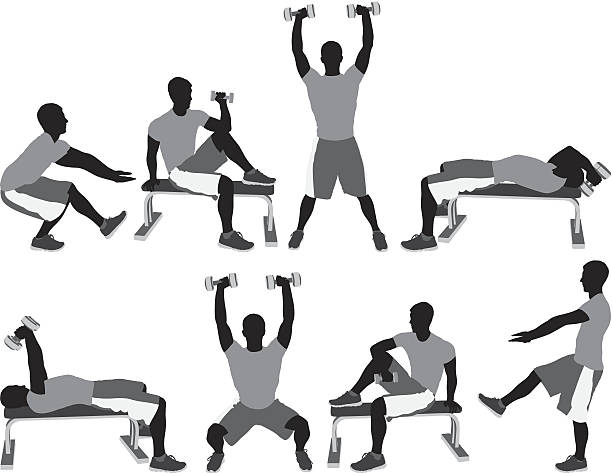
Introduction: Understanding the Role of Triceps in Overall Body Strength
The function of triceps in daily activities:
A considerable percentage of daily activities involve the movement of the arms. Whether picking up groceries, carrying backpacks, opening doors, or throwing a ball, we use our arm muscles and triceps to perform these tasks. The triceps muscle spans from the shoulder to the elbow, creating a large portion of our arm muscles. Hence, any arm movement involving pushing and pulling requires triceps strength. A well-toned triceps muscle makes these daily tasks easier and may lead to injury.
Why triceps strength is essential for other exercises:
In addition to daily activities, triceps strength also plays an integral role in other exercises. For instance, when lifting weights, the triceps support upper body strength and enhance the effect of other exercises like bench presses, pushups, and military presses, making them more effective. A person with weak triceps will find it difficult to perform these exercises, ultimately affecting their overall workout routine. Similarly, aerobic exercises like running, jumping, and swimming require strong upper body muscles, and triceps are vital to this process.

How to build triceps strength:
Building triceps strength is relatively easy and requires some discipline and patience. Triceps extensions, dips, skull crushers, and triceps pushdowns are some exercises that primarily engage the triceps muscles. Besides, incorporating compound movements like bench presses and pushups can also help improve triceps strength. Aim for high-volume, high-intensity training to maximise gains and progressively overload the weights. However, it’s important to note that overtraining can cause injuries and muscle strains, so ensure you give your muscles time to rest.
Benefits of building triceps strength:
Besides aiding in daily activities, building triceps strength offers several benefits to our overall health. It enhances the upper body’s stability and balance and improves posture and appearance. Besides, triceps training improves arm strength and power, ultimately improving endurance. Building triceps strength can also help reduce the risk of injury and muscle imbalances, making workouts more manageable and effective.
Anatomy 101: A Quick Look at the Structure of Your Triceps
Your triceps muscle is located on the back of your upper arm and is responsible for extending (straightening) your arm at the elbow joint. It’s made up of three separate heads: the long head, lateral head, and medial head. The long head runs from the top of your shoulder blade and beneath your shoulder joint. The lateral head is on the outer part of the back of the arm. The medial head is closer to the centre of the back of the arm.
When you perform exercises that involve straightening your arm (like a push-up or a tricep extension), your triceps contract and shorten. This contraction creates tension in the muscle which pulls on the tendon that connects your triceps to your elbow. This results in the extension (straightening) of your arm. When you want to relax your tricep, your brain signals the muscle to release the tension and allow your arm to bend again.
To build up your triceps, it’s important to focus on exercises that target all three heads of the muscle. Exercises like triceps dips, close-grip push-ups, and tricep extensions can help you achieve this. Working on different angles, range of motion, and resistance is also important to keep challenging your muscle and promote growth.

The Importance of Triceps Training in Your Weekly Workout Routine
First and foremost, incorporating tricep training into your weekly workout routine offers many benefits. One significant benefit is increased arm strength. Tricep exercises such as tricep dips and overhead dumbbell extensions help strengthen and develop the muscles responsible for extending your arms. In addition, stronger triceps can provide better assistance to other muscle groups during compound exercises, such as the bench press, increasing your overall strength and performance.
Another benefit of tricep training is tone and definition. While bicep workouts may receive more attention, well-defined triceps are crucial for creating the coveted “cut” or “ripped” appearance. Tricep exercises, such as cable pushdowns and skull crushers, tone and define the muscle, creating a defined look that complements the rest of your upper body.
Tricep training also plays a crucial role in preventing injury. Whether you’re a student-athlete or workout enthusiast, engaging in several tricep exercises will ensure a balanced muscle structure. Neglecting tricep training may lead to muscle imbalances, which can cause injuries such as tendonitis, strains, and sprains.
While triceps are essential for arm movements such as pushing, they complement other muscle group workouts in arm training. For example, bicep curls are incomplete without tricep exercises that help balance the arm’s strength and improve elbow extension. Furthermore, shoulder workouts such as shoulder presses and lateral raises require stable and strong triceps to complete the movements, preventing shoulder injuries and enhancing overall strength.
How Many Sets for Triceps per Week? Unravelling the Mystery
The exact number of sets of triceps exercises per week that you should do depends on various factors such as your fitness goals, age, fitness level, etc. However, experts recommend that teenagers between 13 and 18 should do at least 2 to 3 sets of triceps exercises per week.
If you are a beginner, you should start with 2 exercises per week and gradually increase the number of sets as you progress. On the other hand, if you are an experienced triceps builder, you can do up to 4-5 sets of exercises per week.
It is essential to remember that doing too much exercise can cause injury and may prevent you from achieving your goals. Therefore, starting slowly, monitoring your strength, and increasing your sets gradually over time is crucial.
The frequency of your triceps exercise is also important. For optimal results, aim to work out your triceps at least twice a week with at least one day of rest in between sessions.
When it comes to choosing triceps exercises, always choose a variety of exercises that target different parts of your triceps. Some examples of triceps exercises include dips, cable pushdowns, push-ups, and overhead triceps extensions.
In summary, how many sets of exercises you should do in a week for your triceps depends on many factors. However, teens between 13 and 18 should do at least 2-3 sets per week, starting with 2 sets and gradually increasing over time. Always monitor your strength and progress gradually. Choose a variety of exercises to target different parts more muscle growth, of your triceps, and work out your triceps at least twice a week with a day of rest in between sessions.
Factors to Consider When Determining Your Tricep Set Count
1. Your Current Fitness Level and Goals:
The first factor to consider when determining your tricep set count is your current fitness level and the goals you want to achieve. If you’re starting and working to build muscle from a baseline level of strength, you may want to start with fewer sets per workout (such as 2-3 sets of each exercise) and gradually increase as your strength improves. Conversely, suppose you’re an experienced lifter to improve tricep size and definition. In that case, you may need to perform more sets per workout (such as 4-5 sets of each exercise) to effectively challenge your triceps and stimulate muscle growth.
2. Your Recovery Capacity:
Another key factor to consider is your body’s ability to recover from workouts. If you’re prone to muscle soreness and fatigue, you may need to perform fewer sets per workout and take longer rest periods in order to allow your triceps to recover between sets fully. On the other hand, if you bounce back quickly from workouts, you may be able to perform more sets with shorter rest periods in order to maximize your training volume.
3. Your Training Frequency:
The number of tricep sets you perform per workout should also be influenced by your overall training frequency. If you’re performing tricep exercises multiple times per week (such as in a full-body routine), you may need to perform fewer sets per workout to avoid overtraining. Conversely, if you’re only training your triceps once or twice per week, you may need to perform more sets per workout to challenge your triceps and maximise your overall training volume and efficiency fully.
4. The Importance of Listening to Your Body:
Ultimately, the most important factor to consider when determining your tricep set count is how your body responds to training. Suppose you feel consistently fatigued and sore after your tricep workouts. In that case, you may need to reduce your set count or adjust your other training variables to allow for a full recovery. On the other hand, if you feel energized and ready for more after your tricep workouts, you can increase your set count and push yourself harder.

Case Study: The Impact of High Volume vs Low Volume on Tricep Development
Case Study 1: High-volume training results
High-volume training involves performing many sets and reps of a given exercise to target a muscle group. In a case study published by the Journal of Strength and Conditioning Research, the researchers evaluated the effects of high-volume training on triceps development. They followed a group of healthy young males for 8 weeks, during which each subject completed weekly training volume of three to five sets of eight to twelve repetitions of a triceps extension exercise.
The results showed that high-volume training significantly improved the strength and size of the triceps muscles. The researchers found that mobility and flexibility also improved in the participants. However, on the flip side, high-volume training might lead to exhaustion and burnout if not performed with proper technique and supervision.
Case Study 2: Low-volume training results
On the other hand, low-volume training involves only performing movements in a smaller number of sets and reps with a heavier weight to avoid fatigue and exhaustion. In another case study, researchers compared the effects of low-volume and high-volume training on the triceps muscle in a group of trained young adults. The participants followed a six-week training program that involved a triceps pushdown exercise, either with high volume (three sets of 12-15 reps) or low volume (one set of 4-6 reps).
The results showed that both high-volume and low-volume training led to significant gains in the strength and size of the triceps muscle. The researchers concluded that low-volume training was more effective in improving muscle thickness and hardness, while high-volume training increased muscle mass and cross-sectional area.
Expert Opinions: What Top Trainers Say About Tricep Sets Per Week
Expert Opinion 1: Jim Stoppani, PhD, Exercise Physiologist
According to Jim Stoppani, PhD, exercise physiologist, performing at least six sets per triceps workout is best. He recommends dividing those six sets up among different exercises for maximum results. You can do two to three sets of heavy compound exercises like dips or close-grip bench presses for better strength gains. Follow that up with another two to three sets of isolation exercises like triceps pushdowns or skull crushers for better muscle hypertrophy.
Expert Opinion 2: Lee Haney, Mr. Olympia
Lee Haney, a former bodybuilder and eight-time Mr Olympia suggests working your triceps twice a week. He advises doing three to four sets of three different exercises for each workout. That’s a total of six to eight sets per week. Haney encourages doing a mix of compound exercises like dips and bench presses and isolation exercises like cable pushdowns and overhead extensions. He believes this approach will help you build both strength and size in your triceps.
Expert Opinion 3: Bret Contreras, PhD, Strength Coach
Bret Contreras, PhD, is a world-renowned strength coach known for his work on glute training. However, he also has strong opinions on triceps training. He advocates for high-frequency training of the triceps for better hypertrophy. Contreras suggests training your triceps three times a week, with three sets for arm workout and three different exercises per workout. That’s a total of nine sets per week exclusively for your triceps. However, you should ensure you’re giving your triceps enough time to recover if you decide to follow this approach.
Expert Opinion 4: Arnold Schwarzenegger, Mr. Olympia
Arnold Schwarzenegger, a worldwide bodybuilding and strength training icon, suggests a different approach. According to him, it’s not about the number of sets you do per week but the intensity and focus of your workouts. He recommends doing three to four sets with heavy weights for compound exercises like dips and bench presses. Then, follow that up with lighter weight for higher reps for isolation exercises like cable pushdowns and triceps kickbacks. He believes this approach will help you achieve a balanced and well-proportioned triceps.

Customizing Your Tricep Workout Based on Your Fitness Goals
Tailoring your workout for strength gains:
If your goal is to improve your strength, your workout routine should focus on lifting heavier weights with fewer reps. This type of workout is called low volume, high intensity. For example, you can do close-grip bench presses, dips, and overhead tricep extensions. Make sure to lift with maximum effort and rest for at least 2 minutes between sets to allow your muscles to recover fully. By focusing on strength gains, you will increase your tricep strength and improve your overall fitness level.
Tailoring your workout for muscle size:
If you want to increase the size of your triceps, then your workout should focus on high-volume, moderate-intensity exercises. This type of training entails performing exercises with a high number of reps and sets with moderate weights. Some of the exercises you can include in your workout routine are triceps pushdowns, skull crushers, and tricep kickbacks. It’s important to maintain good form throughout the exercise and to rest for 1-2 minutes between sets. By following this workout routine, you will increase the size of your triceps and improve your muscle definition.
Incorporating variety into your workout:
No matter your fitness goals, adding variety to your tricep workout routine is essential. Repeating the same exercises could lead to a plateau, where you stop seeing progress. Incorporating different exercises into your routine’ll challenge your muscles differently, leading to more gains. You can add exercises like lying tricep extensions, overhead cable extensions, and bench dips to your routine. Keep challenging yourself and trying new exercises to avoid boredom with your workout.

Effective Tricep Exercises to Incorporate Into Your Routine
Exercise 1: The Tricep Dip
One of the best tricep exercises you can do is the tricep dip. This super effective exercise targets your triceps, shoulders, and chest muscles. The best part is it can be done anywhere, and you don’t need any weights or equipment to do it. Just find a stable surface, such as a bench or chair, and place your palms shoulder-width apart on it. Here’s how to perform the exercise:
1. Sit on a bench or chair, keeping your feet on the floor.
2. Place your hands behind you on the edge of the bench or chair.
3. Lower your body by bending your arms, ensuring that your elbows point backwards, keep your wrists straight, and your shoulders relaxed.
4. Push yourself back up using your triceps.
5. Repeat this for three sets of 15 reps.
Exercise 2: Close-Grip Bench Press
This classic tricep exercise is very effective in building excellent arm muscles. Here’s how to do the exercise:
1. Lie on a bench with your feet flat on the floor.
2. Grab a barbell and place your hands shoulder-width apart.
3. Lower the bar with control until it’s just above your chest.
4. Push the bar back up until your arms are straight. Engage your triceps and chest muscles to help you raise the weight.
5. Repeat this for three sets of 10 reps.
Exercise 3: Skull Crushers
Skull crushers are another exercise that you can incorporate into your regime to help work those triceps. Here’s how to do it:
1. Lie on a flat or incline bench with your feet on the floor.
2. Grab a barbell with an overhand grip and straighten your arms upward.
3. Lower the weight of train arms behind your head with control, bending your elbows.
4. Keep your elbows still, and extend your arms to lift the weight back up to the starting position.
5. Repeat this for three sets of 15 reps.
Exercise 4: Overhead Dumbbell Extension
This exercise helps work several parts of most muscles of the arm, including the triceps, biceps, and deltoids. Here’s how to do it:
1. Take a dumbbell in both hands and raise it above your head, ensuring your palms face upwards.
2. Keep your elbows close to your ears and bend them downward.
3. extend your forearms back up to the starting position without moving your upper arms.
4. Repeat this for three sets of 10 reps.

Nutrition’s Role in Tricep Development and Recovery
1. Macronutrients for muscle growth and recovery
Building muscle requires a calorie surplus, meaning you must consume more calories than your body burns. However, not all calories are created equal. It would be best if you had a combination of macronutrients – protein, carbohydrates, and fats – to support muscle growth and recovery. Protein, for instance, is an essential nutrient that provides the building blocks (amino acids) for muscle tissue repair and growth. Aim for at least 1 gram of protein per pound of body weight daily from sources such as lean meats, fish, eggs, beans, and dairy products.
Carbohydrates, on the other hand, are important for energy to fuel your workouts. Complex carbohydrates such as whole-grain bread, rice, and pasta provide sustained energy without spiking your blood sugar levels. Fats are also crucial for hormone and cell function, but choosing healthy fats such as nuts, seeds, avocados, and fatty fish is essential.
2. Micronutrients for muscle health and recovery
While macronutrients are the most talked-about regarding muscle building, micronutrients such as vitamins and minerals also play a vital role. For instance, vitamin C is an antioxidant that helps reduce inflammation in the muscles after exercise. Good sources include citrus fruits, bell peppers, and leafy greens. Magnesium, on the other hand, is important for muscle relaxation and prevents cramping. Foods rich in magnesium include nuts, seeds, and leafy greens.
3. Timing of meals and supplements
The timing of your meals and supplements is also essential for tricep development and recovery. Consuming protein and carbohydrates within 30 minutes of your workout is recommended to replenish energy stores and stimulate muscle protein synthesis. Supplementing with whey protein powder or BCAAs (branched-chain amino acids) can also aid in muscle recovery.
4. Hydration for muscle performance
Lastly, staying hydrated is crucial for optimal muscle performance. Dehydration can lead to decreased strength, power, and endurance, affecting your tricep exercises and overall athletic performance. Aim to drink at least 8-10 glasses of water daily and more if you exercise in hot or humid conditions.
Advanced Techniques for Maximizing Tricep Growth
Tricep muscles are an essential part of your bodybuilding routine, which can help you achieve those defined and toned arms. However, if you have hit a plateau in your tricep growth, do not worry. I am going to explain two advanced techniques that will help you take your tricep growth to the next level.
Technique 1: Drop Set Training
Drop set training is a popular technique that can help you in maximizing your tricep growth. In this technique, you perform an exercise until exhaustion, then immediately drop the weight and perform another set without rest. You can repeat this process several times until you can no longer perform the exercise. The idea behind this technique is to fatigue your muscles and thus maximize muscle growth and fibre recruitment.
The benefits of drop set training are that it can help you achieve a pump, which is a term used to describe the temporary swelling of your muscles due to increased blood flow. This technique can also help you break through a plateau and increase your endurance. Drop-set training can save you time, as you can complete your workout in less time by combining several sets into one.
Technique 2: Supersets
Supersets are another popular technique that you can use to maximize your tricep growth. In this technique, you perform two exercises back to back without any rest in between. The idea behind this technique is to overload your muscles and increase muscle fibre recruitment.
The benefits of supersets are that they can help you save time, as you can complete your workout faster by combining several exercises. Additionally, supersets can help you increase your strength and endurance. In addition, superset training can prevent boredom and challenge different muscle groups.

Pro Tips for Advanced Triceps Growth
1. Incorporate a variety of exercises into your workout routine. This will help ensure that you’re targeting your triceps muscles from different angles, which can help maximize your triceps growth.
2. Focus on your form and technique. Proper form can help you target the right muscle groups and reduce your risk of injury.
3. Increase your weight gradually. Gradual progression can help you avoid injury and maximize your muscle growth.
4. Rest and recover. Rest is important for muscle recovery and preventing injury. Additionally, adequate sleep and nutrition are essential for optimal muscle growth.
Conclusion: Crafting the Optimal Tricep Training Plan for Your Needs.
You should train your triceps 2-3 times a week with at least a day of rest to allow your muscles to recover. In terms of intensity, you should aim for a weight that you can do 8-12 reps of with proper form. Don’t worry how much volume or if you feel like you’re not lifting heavy weights – the most important thing is to focus on the mind-muscle connection and feel the burn in your triceps during your workout.
When crafting your training plan, consider incorporating variation in your exercises. Doing different exercises will challenge your muscles in different ways, leading to better overall development. Examples of exercises include push-ups, tricep dips, overhead tricep extensions, and tricep kickbacks. Always start with lighter weights and gradually increase over time to avoid injury.
Finally, diet and rest are just as important as your workout routine. To build muscles, you need to consume enough protein to support muscle growth. On average, you should aim for about 1 gram of protein per pound of body weight. Additionally, get enough sleep and rest to allow your muscles to repair and grow.


Leave a Reply